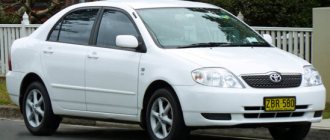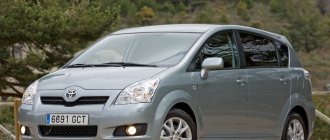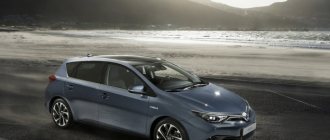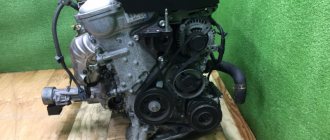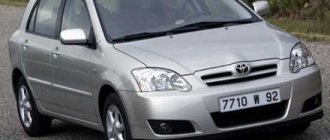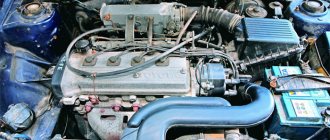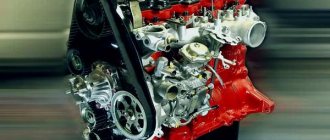Toyota Corolla E11 (1997-2002)
HISTORY 1997 – debut of the eighth generation 1998 – restyling 1999 – restyling 2002 – change of generations
EXTERIOR/INTERIOR All four main versions - sedan, three-door hatchback, five-door hatchback (Liftback for Toyota) and Wagon station wagon - have significant external differences from each other. This was the case in the previous generation, but in the E11 body the “gap” only deepened.
What does this matter to us, car owners? And the fact that frequent and small changes make it difficult to find spare parts! Sellers are forced to keep large warehouses (or transport parts to order), and buyers have to wait and pay money. The worst thing for a Corolla owner is an accident. Because you can’t just come to the market and say: “Get me a bumper for a Toyota Corolla.” You will have to at least clarify what body you have and the year of manufacture.
As for anti-corrosion protection, no rust has yet been noticed on the Corolla in the E11 body. Although, the owners note that after a strong blow that damages the paintwork, the alloy steel still becomes covered with rust.
ENGINES Toyota diesel engines are a role model for other Japanese automakers. Unpretentious, “omnivorous”, with a huge resource. And no newfangled direct injections, which, in general, is surprising for a model of the late 90s.
Gasoline engines also have few disadvantages. But there are features that the owner should know about. Firstly, small Toyota engines (especially 4A-FE) are prone to “eating up” oil after 120 thousand km. Replacing the valve stem seals is most likely useless, since oil leakage begins due to wear on the piston rings. However, up to a mileage of 300 thousand km, oil consumption remains stable, 1-2 liters per 10,000 km, and does not progress, and only then begins to increase due to general natural wear and tear of the engine.
Feature No. 2 - when replacing the timing belt, you need to lift the valve cover. And if so, then in addition to the belt and rollers, immediately buy a valve cover gasket, camshaft and crankshaft seals.
The third feature is the backlash-free gear drive of the intake camshaft, thanks to which the Toyota engine runs very quietly. The timing belt drives the “exhaust” camshaft, and from it, with the help of a special gear, the second shaft rotates. Inside this sprocket there is a special spiral spring, which must be secured with a special nut when removing and installing the camshaft. If this is not done (and some would-be craftsmen even deliberately throw out an “unnecessary” spiral of unknown purpose), the spring may be lost, and then the engine will run very noisily, like a diesel engine.
Therefore, if you are going to adjust the thermal clearances of the valves (Toyota engines do not have hydraulic compensators, so technically the clearances need to be checked every 40 thousand km), replace the oil seals, or carry out any other repairs related to the removal of camshafts, contact a specialist. And if you come across a gasoline Corolla on the market, the engine of which, however, rumbles like a diesel engine, know that the noise probably arose after unqualified repairs.
More modern engines with variable valve timing (VVT-i), which appeared on the Corolla after the 1999 modernization, have a timing chain drive. But these engines are much more demanding on oil quality, because the phase shifter is a hydraulic device driven by oil pressure (as on the first generation Honda VTEC engines). Therefore, the first rule of the owner of a Corolla with a VVT-i engine is to buy expensive, high-quality oil and change it on time.
TRANSMISSION In addition to the standard 5-speed manual transmission, a 6-speed manual transmission (G6 modification for 1.3 liters before restyling, as well as 1.4-1.6 liters after restyling) and a 3-speed automatic transmission were also possible for some versions. for 1.3-1.4 l. The 1.6-liter version had a 4-speed automatic transmission.
The all-wheel drive Corolla Wagon station wagon with a 1.8-liter gasoline engine stands out. The fact is that all three of these components - engine, transmission and station wagon - were available in only one combination on the European market. Therefore, if you come across an all-wheel drive Corolla, keep your eyes open: the rarity of the model guarantees difficulties in finding “used” spare parts.
CHASSIS 60-70 thousand - service life of stabilizer struts. Wear of the silent blocks is not observed even after 100 thousand km, provided that the shock absorbers are changed in time. Serviceable shock absorbers absorb the lion's share of the load from road irregularities, and silent blocks last a long time.
The rear suspension is a typical Japanese “three-link” with anti-roll bar. There are practically no rubber-metal silent blocks familiar to Europeans here; everything is attached with bolts and nuts. Moreover, the rear wishbone consists of two parts, which are also fastened with a threaded connection with nuts.
According to factory technology, silent blocks are poured into the bushings of the levers and are replaced only as a whole - both in the front and rear suspension. But if the front levers are also non-original, then the rear non-original levers do not exist in nature, just as there are no non-original silent blocks of good quality. You may be able to find individual silent blocks made in Taiwan and China for sale, but you should not buy them - you will only get to the garage gate.
Shock absorbers are quite expensive, and when buying a new one, you may be asked for which market your Corolla was produced: for some countries in Northern and Southern Europe, special springs and shock absorbers were installed. Even the steering knuckles on cars from 1997-1999 come in two types!
Some modifications of Toyota Corolla E11
| Years of manufacture | 1997-2000 | 2000-2002 | 2000-2002 | 1997-2000 | 1997-2000 | 2000-2002 | 2000-2002 | 1997-2000 | 2000-2002 | 1997-2000 | 2000-2002 |
| Model | 1.3i 16V | 1.4 VVTi 16V | 1.4 VVTi 16V G6 | 1.6i 16V | 1.6i 16V Wagon | 1.6 VVT-i 16V | 1.6 VVT-i 16V G6 | 1.8i 16V Wagon 4WD | 1.8i 16V Wagon 4WD | 2.0D | 1.9D |
| Engine code | 4E-FE | 4ZZ-FE | 4ZZ-FE | 4A-FE | 4A-FE | 3ZZ-FE | 3ZZ-FE | 7A-FE | 7A-FE | 2C-E | 1WZ |
| Working volume, cm3 | 1332 | 1398 | 1398 | 1587 | 1587 | 1598 | 1598 | 1762 | 1762 | 1975 | 1868 |
| Power, hp | 86 | 97 | 97 | 110 | 107 | 110 | 110 | 110 | 110 | 72 | 69 |
| Acceleration 0-100 km/h, sec. | 12,5 | 11,8 | 11,6 | 10,2 | n.d. | 10,0 | 9,8 | 11,8 | 11,8 | 14,4 | 15,6 |
| Maximum speed, km/h | 175 | 185 | 185 | 195 | n.d. | 195 | 195 | 180 | 180 | 165 | 165 |
| Fuel consumption, l/100 km | 5,7/8,6 | 5,6/8,8 | 5,8/9,2 | 6,4/10,3 | n.d. | 5,9/9,1 | 6,1/9,8 | 7,8/12,4 | 7,8/11,8 | 5,3/8,4 | 5,3/8,6 |
Toyota Corolla Liftback E11 1.3i 16V (86 hp), 1997 FIRST THING
| Detail | Price, USD* |
| Oil filter | 3-7 |
| Air filter | 8-15 |
| Fuel filter | 7-28 |
| Cabin filter | 17-30 |
| Cylinder head gasket | 8-30 |
| Timing belt and rollers | 13-35** + 16-43** + 2** + 2** + 14-39** |
| Water pump | 22-53** |
| Clutch release bearing | 17-30 |
| Clutch disc | 20-63** |
| Clutch kit | 95-170 |
| Front disc brake pads | 20-60 |
| Rear drum brake pads | 14-35 |
| Front brake disc | 24-84** |
| Front wheel bearing | 15-55** |
| Front hub | 70** |
| Rear hub | 45-170** (85-215** with ABS) |
| Front suspension wishbone | 55-130** |
| Front ball joint | 12-55** |
| Silent block of the front lever | — |
| Front stabilizer link | 9-27** |
| Rear suspension trailing arm | 60** |
| Front wishbone rear suspension | 70** |
| Rear wishbone rear suspension | 92** |
| Front suspension strut support | 58** |
| Front shock absorber | 82-100 |
| Rear shock absorber | 80-135 |
| Front spring | 50-127** |
| Tie rod end | 7-27** |
| Tie Rod | 10-65** |
* average for Minsk, ** price of original part
Reviews of Toyota Corolla 1997 hatchback 5 doors/Toyota
Toyota Corolla 1.4 MT (2007, Sedan)
Manual transmission 1398 cm³ Left 60,000 km 130,000 km
Russia Stavropol Territory
Pavel 05/08/2013:
“I bought a car in July 2011 with a mileage of about 60,000 km, to be honest, I expected not much worse, I heard about the reliability of Japanese cars, but I didn’t think that they were that reliable.
Over the entire period of my operation, in addition to consumables, I only changed some kind of oil seal in the front suspension, the cost was 150 rubles. and that's all. All other work is according to regulations. Spark plugs, oil, pads. Before the sale, the buyer insisted on a visit to the service center and carried out a full diagnosis of the car, I was simply surprised: firmly (in a circle) in good condition (installed at the factory), the front brake pads were worn out by 60-70% (also factory, I only changed the rear Even the battery works like a clock (also factory).Now I’ll tell you about the shortcomings: 1. I really didn’t like the plastic used in the interior, after 90,000 km a whole flock of crickets appeared (well, probably this is normal for a car of this class) 2. I was surprised by the work standard audio system: when the car, in the cold season, sits at night not even on the street but in an unheated underground parking lot, in the morning some hieroglyphs are written on the display (apparently it says that the car was cold at night), while the audio system works, but does not switches radio stations, does not turn on CDs, etc. that is, what you finished listening to in the evening, this is what you will be listening to for the near future until the interior warms up (1-1.5 hours), cool thing. 3. The control button for the on-board computer is located on the dashboard, in order to see some readings you need to be very tricky...on the move - the maneuver can be dangerous. 4. The paintwork is very susceptible to flying stones, the whole hood is speckled. but I repeat, this is an excellent car, in -30 frost it sat in the yard for 4 days, I didn’t even hope to start it in the morning, I tried it just out of interest (I even called a taxi to go to work), but of course I underestimated JAPANESE QUALITY!!! With half a turn the car started up like in the summer. In general, in my opinion, this car has fewer pros than cons. Highly recommend. Good luck to everyone on the roads. The car has no problems at all! There are some minor shortcomings: 1. I really didn’t like the plastic used in the interior, after 90,000 km. a whole flock of crickets appeared (well, this is probably normal for a car of this class) 2. I was surprised by the work of the standard audio system: when the car, in the cold season, sits at night not even on the street but in an unheated underground parking lot, in the morning some hieroglyphs are written on the display ( Apparently he says that the car was cold at night), while the audio system works, but does not switch radio stations, does not turn on CDs, etc. that is, what you finished listening to in the evening is what you will be listening to in the near future until the interior warms up (1-1.5 hours), cool stuff. 3. The control button for the on-board computer is located on the dashboard, in order to view any readings you need to be very tricky...on the move - the maneuver can be dangerous. 4. The paintwork is very susceptible to flying stones, the whole hood is speckled. » expandcollapse
All owner reviews about Toyota Corolla E100
The day has come when you can share not only emotions, but also a realistic approach to evaluating a car. After all, I drove it for two whole years - I covered 50,000 km. Still, a little emotion needs to be introduced at the beginning of the review. Because, no matter what, I still madly love this little girl, who every day, with her engine purring so tenderly, begs for “jewels” in the form of AI-92 gasoline, which is so expensive in our time, in a country with the most large reserves of oil. But it’s impossible to refuse this little girl. So, let's begin our story about my favorite corolla (Corolla is the literal translation of Corolla)... Introduction. I didn’t have a license then, and I never dreamed of owning a personal car. I simply raved about them. Because of this, I almost broke my neck while walking along the street along the roadway. I involuntarily turned my head sharply towards the road, catching my gaze as the car rushed past. It was a handsome Land Cruiser, all kitted out, and a second later, in the oncoming traffic, growling as if a tank was driving Patrol on huge wheels, tuned for off-road use, the Mercedes M stopped at a traffic light. It was as if the red light was shining not only for the German, but also for me. We both stood on red, looking at each other - I with my eyes, he with my headlights. I contemplated the beauty of the body lines and was terribly jealous of the owner of the M-ki. The light turned green, the Mercedes set off with me, but our roads missed each other in opposite directions. I walked forward, and he drove further and further, winking at me with his turn signal, changing lanes from his lane to the next one.
Then there were more cars and more: Camry, Rav4, X-Trail, RX, Pajero, Prado, etc. The flow of cars made my head spin. Girls walked by that would never even be dreamed of in the most erotic dreams, and I was staring not at them, but at the cars. Yes, you need to buy a car urgently. But first, right. No - first the car, and then the license. The first one makes more sense, but I did the second one. And I applied for a driver’s license myself (there were only two of us who passed) - I didn’t buy it. Everything is fine, just which car to take. There was no money for a foreign car; they didn’t give me a loan; it wasn’t enough. After thinking for a long time, I bought a 22-year-old VAZ 2102 for 22 thousand rubles. Part one. VAZ 2102. A brief history of the first car. 2004 I'm the third owner. The car was received in good condition for a “two”. There were only four rotten holes in the floor, there was no window regulator (it was replaced by a screwdriver inserted between the glass and the door in the crack), a starter, a handbrake cable, there was no radio at all, and there was something else missing, I don’t remember now. But it is not important. And the important thing is that now I have MY OWN car.
